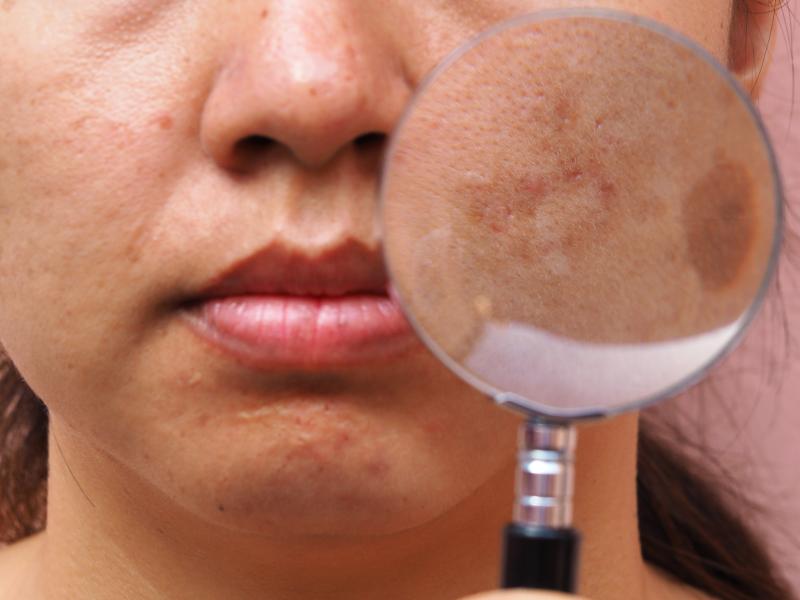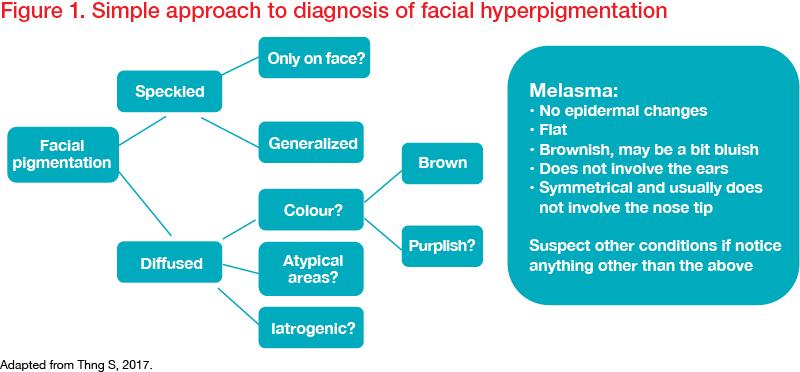New paradigms in facial hyperpigmentation management









Depigmentation creams and laser therapy have been the mainstay of treatment for facial hyperpigmentation. However, these treatments are not universally effective and some have resulted in worsening of conditions in some patients. At a symposium organized by the Society of Physicians of Hong Kong, Dr Steven Thng of the National Skin Centre, Singapore, shared his experience on diagnosing and personalizing treatment for facial hyperpigmentation. He also presented interesting findings from his own as well as other recent research that lit the way to new paradigms in the management of skin hyperpigmentation.
Paradigm shift 1: Making the right diagnosis
“First and foremost, get the diagnosis right. Not all facial hyperpigmentation can be treated in the same manner,” Thng emphasized.
“Facial hyperpigmentation can be a manifestation of an underlying condition, such as systemic diseases or internal malignancies,” said Thng. “Sadly, some patients with facial hyperpigmentation suffer from adverse side effects in the hands of beauticians and even doctors because of a wrong treatment given due to a misdiagnosis.”
“For example, a patient with what seems like freckles may, on closer examination, have neurocutaneous signs on the rest of the body suggestive of lentiginosis. This patient should be sent for further evaluation to rule out any other organ malformations,” he noted. “Other skin conditions, such as atypical acanthosis nigricans which presents as facial pigmentation, might indicate internal malignancies, whereas conditions such as lichen planus pigmentosus would be aggravated by laser treatment.”
“Pigmented contact dermatitis, drug-induced pigmentation, poikiloderma of Civatte and ochronosis are often misdiagnosed as melasma,” highlighted Thng. “Treatment for these conditions requires removal of aggravating factors, such as cessation of regular rubbing of medicated oil on the bitemporal areas in cases of pigmented contact dermatitis.”
Thng also proposed a simple algorithm to distinguish melasma from other conditions. (Figure 1)
“Our centre is working on a point-of-care smartphone application [app] for the diagnosis of facial hyperpigmentation. It can provide preliminary information on the diagnosis and management of the condition based on photographs of the patient’s face,” said Thng. “We hope that this app will reduce misdiagnoses and inappropriate treatment of facial hyperpigmentation by non-professional and untrained persons.”

Paradigm shift 2: Move beyond UV protection
“Apart from genetics and hormones, especially oestrogens, ultraviolet [UV] light is believed to be a main aggravating factor of melasma. However, melasma often recur despite the use of sunblocks,” said Thng.
Recent studies revealed that visible light (VL), particularly the blue component, causes more pronounced and persistent hyperpigmentation than UV light. This finding is supported by studies showing that UV-VL sunscreen enhances the depigmentation efficacy of hydroquinone in the treatment of melasma compared with UV-only sunscreen. [Pigment Cell Melanoma Res 2014;27:822-826; Photodermatol Photoimmunol Photomed 2014;30:35-42]
“In some melasma patients, biopsies of lesional areas of the skin show an increased number of inflammatory cells compared with nonlesional or perilesional areas despite the absence of itch and redness,” said Thng. “This suggests that subclinical inflammation plays a role in the pathogenesis of melasma. Environmental pollution, nanoparticles such as those present in cosmetics, and friction have been identified as possible causes of such inflammation.” [J Dermatol 2014;41:788-794; J Invest Dermatol 2010;130:2719-2726]
Oxidative stress is the mechanism underlying the inflammatory responses and VL-induced hyperpigmentation. “While topical antioxidants have been shown ineffective, oral antioxidants that concentrate in the skin layers are promising in the treatment of hyperpigmentation. Therefore, oral antioxidants, as well as ways to minimize exposure to environmental pollutants and nanoparticles, have a role in the new treatment paradigm for facial hyperpigmentation,” said Thng.
Paradigm shift 3: Shift away from melanocytes
“The focus of treatment for facial hyperpigmentation should shift from vain attempts at ‘flogging’ the ‘innocent’ melanocytes to targeting surrounding factors that drive melanogenesis ,” Thng emphasized.
“Our study showed that melasma could be associated with keratinocyte dysfunction, suggesting that targeting keratinocytes may be a new treatment approach for melasma,” he said. [Thng et al, unpublished data]
Increased vascularity, mast cell involvement, basement membrane disruption and skin barrier defect also play a role in the pathogenesis of melasma. [J Dermatol Sci 2007;46:111-116; Clinical and Experimental Dermatology 2008;33:305-308; Am J Dermatopathol 2011;33:291-295; J Eur Acad Dermatol Venereol 2012;26:1533-1537]
“Therefore, skin hydration with moisturizers, in addition to the use of sunblocks and bleaching agents, is important when treating melasma,” explained Thng.
Paradigm shift 4: Move away from hydroquinones and triple combination creams
“Clinicians should target as many of the major pathways in melanogenesis as possible when selecting bleaching creams, and use oral antioxidants and/or agents that target the mast cells and vascular components where appropriate. While topical anti-inflammatory agents may still be necessary, laser treatment should be reserved for straightforward cases or as a last resort,” Thng recommended.
New strategies in the pipeline targeting the melanogenesis pathway include increasing tyrosinase destruction with linoleic acid, oleic acid or hexyldecanol, inhibition of melanogenesis-associated transcription factor with metformin, targeting melanocyte/keratinocyte interaction with undecylenoyl phenylalanine, and melanocyte targeted-therapy. [Biochem J 2006;394:43-50; Br J Dermatol 2013;169:39-44; J Invest Dermatol 2014;134:2589-2597; J Cosmet Dermatol 2014;13:86-90]
“Oral tranexamic acid therapy is useful for refractory melasma and is a breakthrough in melasma management that was achieved in Southeast Asia,” said Thng. “An impressive response rate of more than 90 percent was achieved in a retrospective analysis of 653 patients with melasma who received oral tranexamic acid at our centre.” (Figure 2) [J Am Acad Dermatol 2016;75:385-392]
“Importantly, clinicians should screen for personal and familial risk factors for deep vein thrombosis before the initiation of oral tranexamic acid therapy,” he cautioned.

Paradigm shift 5: Quantify pigmentation beyond MASI score
“We need a more refined and accurate method to quantify pigmentation than the widely used Melasma Area and Severity Index [MASI] scoring system, as MASI is subject to inter-observer variability,” said Thng.
“The novel app developed by our centre can calculate the area and degree of hyperpigmentation from whole-face digital photographs, and generate a MASI score,” he continued. “This will truly transform the way we treat, co-manage and encourage patients with facial hyperpigmentation.”